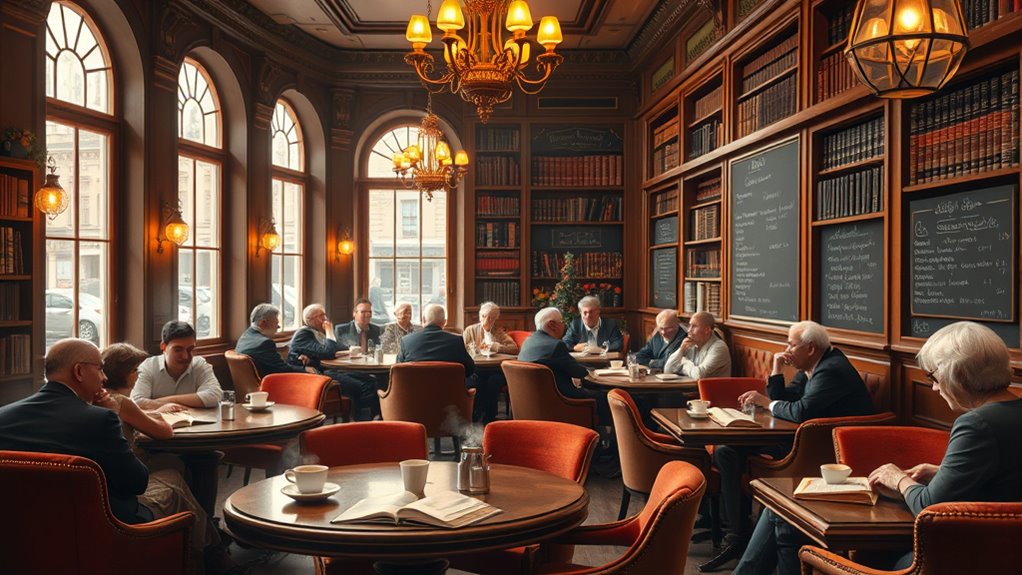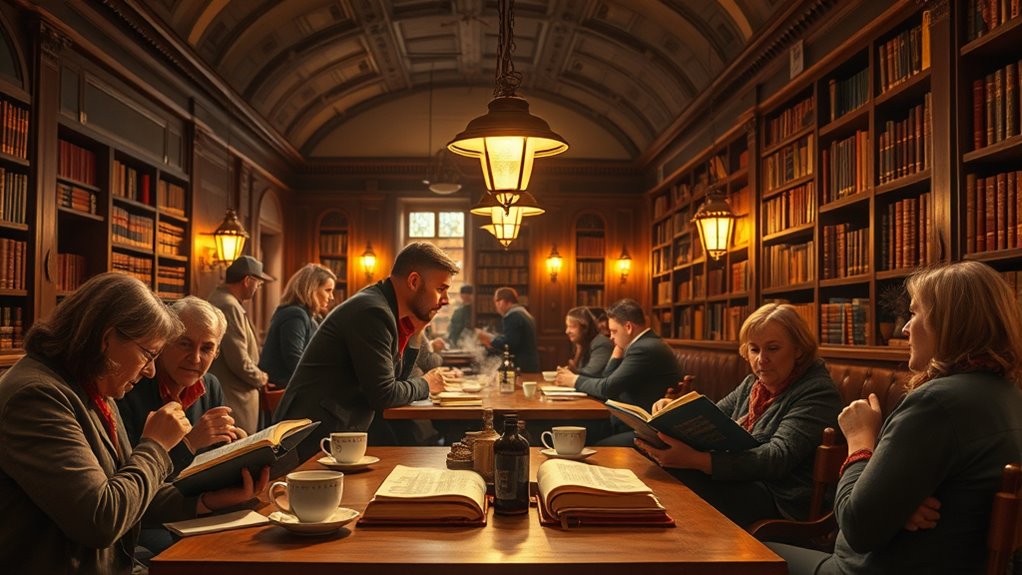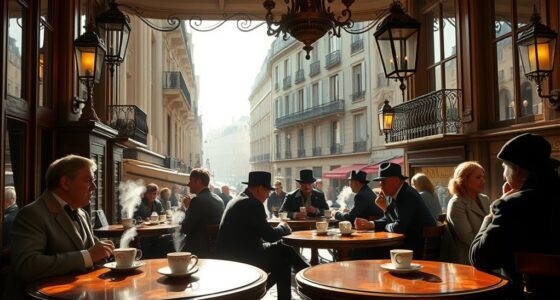Coffeehouses during the Enlightenment were lively hubs where you could engage in debates, share ideas, and connect with diverse social groups. They fostered critical thinking, inspired scientific and political discussions, and even helped organize activism. These gatherings broke down social barriers, creating a space for collective progress and civic engagement. If you explore further, you’ll discover how these “third places” transformed society by shaping public discourse and fueling revolutionary change.
Key Takeaways
- Coffeehouses served as vibrant social hubs for exchanging Enlightenment ideas and fostering critical discussion among diverse social groups.
- They facilitated the spread of revolutionary philosophies, influencing societal shifts and modern concepts of public discourse.
- These spaces enabled collaboration among thinkers, writers, and citizens, acting as “literary third places” for intellectual engagement.
- Coffeehouses supported the dissemination of literature, pamphlets, and news, accelerating enlightenment and revolutionary movements.
- They promoted a culture of inquiry and debate, shaping the development of modern democratic and activist practices.

Coffeehouses played a pivotal role in fueling the intellectual fervor of the Enlightenment by becoming vibrant centers for discussion, debate, and the exchange of ideas. These establishments weren’t just places to grab a quick drink; they served as social networks that connected people across different classes, backgrounds, and professions. As you step into a typical coffeehouse of the time, you realize it’s a lively hub where thinkers, merchants, writers, and everyday citizens converge. Conversations here often revolve around philosophy, science, politics, and morality, creating a dynamic environment that stimulates critical thinking and innovation. Because of this, coffeehouses became essential spaces for the dissemination of Enlightenment ideals, helping to spread new ideas rapidly through oral exchange and printed materials.
Coffeehouses were vibrant hubs for debate, connecting diverse minds and spreading Enlightenment ideas through lively discussion and exchange.
You quickly notice that these venues foster a sense of community and shared purpose. They break down social barriers, allowing people from diverse social strata to exchange ideas freely. This democratization of discussion fuels a sense of collective progress, encouraging individuals to challenge traditional authority and question societal norms. You might find yourself engaging in debates about government, religion, or human rights, often influenced by the revolutionary spirit of the era. These discussions often extend beyond mere conversation—they become acts of political activism. Coffeehouses provided the fertile ground for organizing protests, spreading pamphlets, and forming networks that could challenge the status quo. Because of their accessibility, they became the birthplace of many Enlightenment movements that sought reform and greater individual freedoms.
Moreover, the role of collective action within these spaces was crucial in transforming ideas into tangible societal change, as it empowered ordinary citizens to participate actively in political processes.
Furthermore, the social networks established within coffeehouses extend beyond local boundaries. News travels quickly through these spaces, connecting people across cities and even countries. They served as informal communication channels, enabling the rapid spread of revolutionary ideas and facilitating coordinated activism. If you’re involved in political activism, coffeehouses are where you might meet like-minded individuals or share information about emerging causes. They are spaces that nurture dissent and empower ordinary citizens to become active participants in shaping political change. Their influence persists because they foster a culture of inquiry, debate, and civic engagement, making them essential in transforming Enlightenment philosophies into tangible societal shifts.
In essence, coffeehouses weren’t just places for leisure—they were indispensable engines of social and political change. They created networks that linked individuals, ideas, and movements, fueling the intellectual and revolutionary spirit of the Enlightenment. As you reflect on their role, it becomes clear that these “third places” were integral to shaping modern notions of public discourse, civic participation, and the power of collective action.
Frequently Asked Questions
How Did Coffeehouses Influence Political Debates During the Enlightenment?
Coffeehouses played a vital role in shaping political debates during the Enlightenment. You can see how they became a vibrant public sphere where people gathered to share ideas, challenge authority, and foster political activism. These spaces encouraged open discussion, helping citizens understand different viewpoints and influencing reform movements. By providing a platform for debate, coffeehouses greatly contributed to the spread of Enlightenment ideals and democratic thinking.
Were Women Allowed to Participate Equally in Enlightenment Coffeehouse Conversations?
You might think women had an equal say, but gender participation in enlightenment coffeehouses was limited. While some women’s voices did emerge, they often faced exclusion or marginalization. The irony is that these spaces, meant for free exchange, rarely opened their doors fully to women. So, despite their presence, true gender equality in participation remained elusive, reflecting broader societal constraints of the era.
What Specific Literary Works Were Inspired by Coffeehouse Discussions?
You’ll find that coffeehouse discussions inspired a variety of literary works, especially through literary inspiration and coffeehouse poetry. Writers like Voltaire and Rousseau drew on these lively debates, shaping their ideas into influential texts. Coffeehouses became hubs for exchanging thoughts, fueling creativity, and producing poetry, essays, and novels. These vibrant environments directly influenced literature, making coffeehouse conversations a essential catalyst for enlightenment-era creativity and literary innovation.
How Did Coffeehouses Differ Across Various European Cities During This Period?
You’ll notice that coffeehouses differed across European cities through cultural variations and social dynamics. In Paris, they fostered intellectual debates and artistic exchanges, while in London, they emphasized commerce and political discussion. In Venice, social interactions blended with leisure, reflecting local customs. These differences shaped the atmosphere, influencing who gathered there and what ideas circulated, making each coffeehouse a unique hub of cultural and social activity.
Did Coffeehouses Contribute to the Spread of Revolutionary Ideas Beyond Europe?
Yes, coffeehouses contributed to the spread of revolutionary ideas beyond Europe by fostering global influence and cultural exchange. You can see how ideas traveled quickly through these lively spaces, connecting people from different backgrounds. Coffeehouses became hubs for sharing political thoughts and innovations, influencing movements worldwide. Their role in promoting open discussion helped shape revolutionary shifts across continents, making them key players in the global spread of transformative ideas during the Enlightenment era.
Conclusion
Imagine yourself stepping into a bustling coffeehouse during the Enlightenment, where ideas swirl like steam rising from a hot cup. Just as a single drop can ripple across still water, these cafes sparked conversations that rippled through society, fueling progress. You realize that, like a well-brewed blend, coffeehouses combined diverse minds to create something richer than the sum of their parts—truly the “third place” where enlightenment was brewed and shared.








